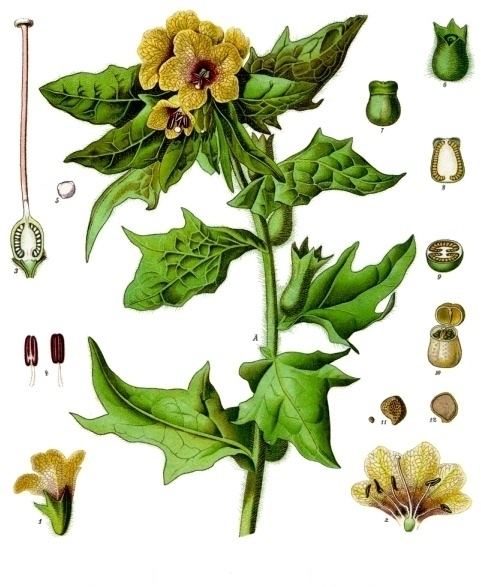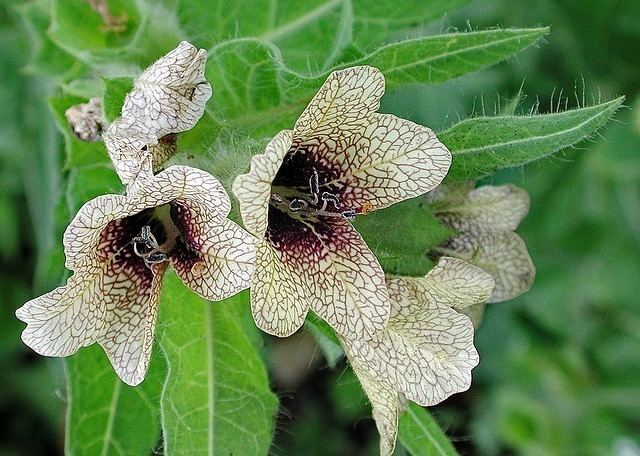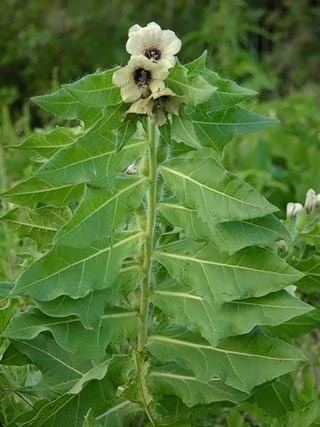Rank Species | Genus Hyoscyamus Higher classification Hyoscyamus | |
 | ||
Similar Hyoscyamus, Jimsonweed, Angel's trumpets, Nightshade, Hemlock | ||
Poisonous plants 1 2 1 hyoscyamus niger black henbane
Hyoscyamus niger, commonly known as henbane, black henbane or stinking nightshade, is a poisonous plant in the family Solanaceae.
Contents
- Poisonous plants 1 2 1 hyoscyamus niger black henbane
- Hyoscyamus niger henbane
- Historical usage
- Cultivation and usage
- Preparation dosage toxicity
- Psychoactive material
- Effects
- Misidentification
- References

Hyoscyamus niger henbane
Historical usage
The name henbane dates at least to AD 1265. The origins of the word are unclear, but "hen" probably originally meant death rather than referring to chickens. Other etymologies of the word associate it with the Indo-European stem *bhelena whose hypothetical meaning is ‘crazy plant’ and with the Proto-Germanic element bil meaning ‘vision, hallucination; magical power, miraculous ability’.

Henbane was historically used in combination with other plants, such as mandrake, deadly nightshade, and datura as an anaesthetic potion, as well as for its psychoactive properties in "magic brews". These psychoactive properties include visual hallucinations and a sensation of flight. It was originally used in continental Europe, Asia, and the Arab world, though it did spread to England in the Middle Ages. The use of henbane by the ancient Greeks was documented by Pliny who said it was "of the nature of wine and therefore offensive to the understanding," and by Dioscorides who recommended it as a sedative and analgesic. The plant, recorded as Herba Apollinaris, was used to yield oracles by the priestesses of Apollo. Recently evidence for its earlier use in the Scottish Neolithic has been debated. John Gerard's Herball states: "The leaves, the seeds and the juice, when taken internally cause an unquiet sleep, like unto the sleep of drunkenness, which continueth long and is deadly to the patient. To wash the feet in a decoction of Henbane, as also the often smelling of the flowers causeth sleep."

Henbane was one of the ingredients in gruit, traditionally used in beers as a flavouring. Several cities, most notable Pilsen, were named after its German name "Bilsenkraut" in context of the production for beer flavouring. The recipe for henbane beer includes 40 g dried chopped henbane herbage, 5 g bayberry, 23 l water, 1 l brewing malt, 900 g honey, 5 g dried yeast, and brown sugar. Henbane fell out of usage for beer when it was replaced by hops in the 11th to 16th centuries, as the Bavarian Purity Law of 1516 outlawed ingredients other than barley, hops, yeast, and water.

Henbane is sometimes identified with the "hebenon" poured into the ear of Hamlet's father, although other candidates for hebenon exist.
Cultivation and usage
Henbane originated in Eurasia, and is now globally distributed as a plant grown mainly for pharmaceutical purposes. Henbane is rare in northern Europe; its cultivation for medicinal use is spread and legal in central and eastern Europe and in India. Henbane is an endangered plant according to the World Conservation Union’s Red List.
Henbane is used within the treatment of bones and rheumatism, toothache, asthma, cough, nervous diseases, and stomach pain. It might also be used as analgesic, sedative, and narcotic in some cultures. Adhesive bondages with henbane extract behind the ear are reported to prevent discomfort in travel-sick people. Henbane oil is used for medicinal massage.
Henbane material in most Western countries can be bought in pharmacies with a prescription only. Sales of henbane oil are not legally regulated and are allowed in shops other than pharmacies.
Preparation, dosage, toxicity
Henbane leaves and herbage without roots are chopped and dried and are then used for medicinal purposes or in incense and smoking blends, in making beer and tea, and in seasoning wine. Henbane leaves are boiled in oil to derive henbane oil. Henbane seeds are an ingredient in incense blends. In all preparations, the dosage has to be carefully estimated due to the high toxicity of henbane. For some therapeutic applications, dosages like 0.5 g and 1.5– 3 g were used. The lethal dosage is not known.
Psychoactive material
Hyoscyamine, scopolamine, and other tropane alkaloids have been found in the foliage and seeds of the plant. The standard alkaloid content has been reported to be 0.03 to 0.28%.
Effects
Henbane ingestion by humans is followed simultaneously by peripheral inhibition and central stimulation. Common effects of henbane ingestion include hallucinations, dilated pupils, restlessness, and flushed skin. Less common effects are tachycardia, convulsions, vomiting, hypertension, hyperpyrexia, and ataxia. Initial effects typically last for three to four hours, while aftereffects may last up to three days. The side effects of henbane ingestion are dryness in the mouth, confusion, locomotor and memory disturbances, and farsightedness. Overdosages result in delirium, coma, respiratory paralysis, and death. Low and average dosages have inebriating and aphrodisiac effects.
Henbane is toxic to cattle, wild animals, fish, and birds. Not all animals are susceptible; for example, the larvae of some Lepidoptera species, including cabbage moths, eat henbane. Pigs are immune to henbane toxicity and are reported to enjoy the effects of the plant.
Misidentification
In 2008, celebrity chef Antony Worrall Thompson recommended henbane as a "tasty addition to salads" in the August 2008 issue of Healthy and Organic Living magazine. He subsequently said he had made an error, confusing the herb with fat hen, a member of the spinach family. He apologized, and the magazine sent subscribers an urgent message stating, "[henbane] is a very toxic plant and should never be eaten".
